User:Louis XVIII/List of Roman Emperors
Appearance
The Principate
[edit]Julio-Claudian dynasty
[edit]| Portrait | Name | Birth | Succession | Reign | Death | Time in Office |
|---|---|---|---|---|---|---|
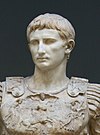
|
Augustus IMPERATOR CAESAR DIVI FILIVS AVGVSTVS |
September 23 63 BC, Rome, Italia | Became de facto emperor as a result of the 'first settlement' between himself and the Roman Senate. | January 16, 27 BC – August 19, 14 AD | August 19, 14 AD Natural causes. |
40 Years, 7 Months and 3 days |

|
Tiberius TIBERIVS IVLIVS CAESAR AVGVSTVS |
November 16 42 BC, Rome | Son of Augustus's wife Livia by a previous marriage; adopted son of Augustus. | September 18, 14 AD – March 16, 37 AD | March 16, 37 AD Probably natural causes, possibly assassinated by Caligula |
22 Years, 6 Months and 2 days |

|
Caligula GAIVS IVLIVS CAESAR AVGVSTVS GERMANICVS |
August 31, 12 AD, Antium, Italia | Tiberius's great-nephew and adopted grandson; great-grandson of Augustus. | March 18, 37 AD – January 24, 41 AD | January 24, 41 AD Assassinated in a conspiracy involving senators and Praetorian Guards. |
3 Years, 10 Months and 6 days |

|
Claudius TIBERIVS CLAVDIVS CAESAR AVGVSTVS GERMANICVS |
August 1, 10 BC, Lugdunum, Gallia Lugdunensis | Nephew of Tiberius, brother of Germanicus and uncle of Caligula; proclaimed emperor by the Praetorian Guard. | January 25/26, 41 AD – October 13, 54 AD | October 13, 54 AD Probably poisoned by his wife Agrippina the Younger, in favour of her son Nero, possibly natural causes. |
13 Years, 9 Months |
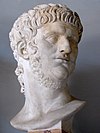
|
Nero NERO CLAUDIUS CAESAR AUGUSTUS GERMANICUS |
December 15, 37 AD, Antium, Italia | Grandson of Germanicus, nephew of Caligula, step- and adopted son of Claudius; great-great-grandson of Augustus. | October 13, 54 AD – June 9, 68 AD | June 9, 68 AD Committed suicide after being declared a public enemy by the Senate. |
13 Years, 8 Months |
Year of the Four Emperors and Flavian Dynasty
[edit]| Portrait | Name | Birth | Succession | Reign | Death | Time in Office |
|---|---|---|---|---|---|---|

|
Galba SERVIVS SVLPICIVS GALBA CAESAR AVGVSTVS |
December 24 3 BC, Near Terracina, Italia | Seized power after Nero's suicide, with support of the Spanish legions | June 8, 68 AD – January 15, 69 AD | January 15, 69 AD Murdered by Praetorian Guard in coup led by Otho. |
7 Months |
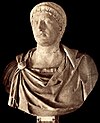
|
Otho MARCVS SALVIVS OTHO CAESAR AVGVSTVS |
April 28, 32 AD, Ferentinum, Etruria, Italia | Appointed by Praetorian Guard | January 15, 69 AD – April 16, 69 AD | April 16, 69 AD Committed suicide after losing Battle of Bedriacum to Vitellius |
3 months 1 day (91 days) |
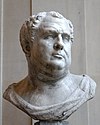
|
Vitellius AVLVS VITELLIVS GERMANICVS AVGVSTVS |
September 24, 15 AD, Rome | Seized power with support of German Legions (in opposition to Galba/Otho) | April 17, 69 AD – December 20, 69 AD | December 20, 69 AD Murdered by Vespasian's troops |
8 Months |
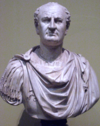
|
Vespasian TITVS FLAVIVS CAESAR VESPASIANVS AVGVSTVS |
November 17, 9 AD, Falacrine, Italia | Seized power with the support of the eastern Legions (in opposition to Vitellius) | July 1, 69 AD – June 24, 79 AD | June 24, 79 AD Natural causes |
10 years |

|
Titus TITVS FLAVIVS CAESAR VESPASIANVS AVGVSTVS |
December 30, 39 AD, Rome | Son of Vespasian | June 24, 79 AD – September 13, 81 AD | September 13, 81 AD Natural causes (Plague) |
2 years, 3 months |

|
Domitian TITVS FLAVIVS CAESAR DOMITIANVS AVGVSTVS |
October 24, 51 AD, Rome | Son of Vespasian | September 14, 81 AD – September 18, 96 AD | September 18, 96 AD Assassinated by court officials |
15 years |
Nervan-Antonian dynasty
[edit]| Portrait | Name | Birth | Succession | Reign | Death | Time in Office |
|---|---|---|---|---|---|---|

|
Nerva MARCVS COCCEIVS NERVA CAESAR AVGVSTVS |
November 8, 30 AD, Narni, Italia | Appointed by the Senate | September 18, 96 AD – January 27, 98 AD | January 27, 98 AD Natural causes |
1 year, 4 months |

|
Trajan CAESAR MARCVS VLPIVS NERVA TRAIANVS AVGVSTVS |
September 18, 53 AD, Italica, Hispania Baetica | Adopted son and heir of Nerva | January 28, 98 AD – August 7, 117 AD | August 7, 117 AD Natural causes |
19 years, 7 months |

|
Hadrian CAESAR PVBLIVS AELIVS TRAIANVS HADRIANVS AVGVSTVS |
January 24, 76 AD, Italica, Hispania Baetica (or Rome) | Adopted son and heir of Trajan | August 11, 117 AD – July 10, 138 AD | July 10, 138 AD Natural causes |
21 years |

|
Antoninus Pius CAESAR TITVS AELIVS HADRIANVS ANTONINVS AVGVSTVS PIVS |
September 19, 86 AD, Near Lanuvium, Italia | Adopted son and heir of Hadrian | July 10, 138 AD – March 7, 161 AD | March 7, 161 AD Natural causes |
22 years, 7 months |

|
Lucius Verus CAESAR LVCIVS AVRELIVS VERVS AVGVSTVS |
December 15, 130 AD, Rome | Adopted son and heir of Antoninus Pius; Co-emperor with Marcus Aurelius until death | March 7, 161 AD – ? March 169 AD | March 169 AD Natural causes (Plague) |
8 years |
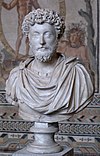
|
Marcus Aurelius CAESAR MARCVS AVRELIVS ANTONINVS AVGVSTVS |
April 26, 121 AD, Rome | Adopted son and heir of Antoninus Pius; Co-emperor with Lucius Verus until 169 AD | March 7, 161 AD – March 17, 180 AD | March 17, 180 AD Natural causes |
19 years |

|
Commodus CAESAR MARCVS AVRELIVS COMMODVS ANTONINVS AVGVSTVS |
August 31, 161 AD, Lanuvium, Italia | Natural son of Marcus Aurelius; joint emperor from 177 AD | 177 AD – December 31, 192 AD | December 31, 192 AD Assassinated in palace, strangled to death |
15 years, |
Year of the Five Emperors & Severan dynasty
[edit]| Portrait | Name | Birth | Succession | Reign | Death | Time in Office |
|---|---|---|---|---|---|---|

|
Pertinax CAESAR PVBLIVS HELVIVS PERTINAX AVGVSTVS |
August 1, 126 AD, Alba, Italia | Proclaimed emperor by Praetorian Guard | January 1, 193 AD – March 28, 193 AD | March 28, 193 AD Murdered by Praetorian Guard |
3 months |

|
Didius Julianus CAESAR MARCVS DIDIVS SEVERVS IVLIANVS AVGVSTVS |
133 or 137 AD, Milan, Italia | Won auction held by the Praetorian Guard for the position of emperor | March 28, 193 AD – June 1, 193 AD | June 1, 193 AD Executed on orders of the Senate |
2 months 4 days (65 days) |

|
Septimius Severus CAESAR LVCIVS SEPTIMIVS SEVERVS PERTINAX AVGVSTVS |
April 11, 145 AD, Leptis Magna, Libya | Seized power with support of Pannonian legions[1] | April 9, 193 AD – February 4, 211 AD | February 4, 211 AD Natural causes |
17 years, 10 months |
| Caracalla CAESAR MARCVS AVRELIVS SEVERVS ANTONINVS PIVS AVGVSTVS |
April 4, 188 AD, Lugdunum, Gallia Lugdunensis | Son of Septimius Severus; co-emperor with Severus from 198 AD; with Severus and Geta from 209 AD until February 211 AD; co-emperor with Geta until December 211 AD | 198 AD – April 8, 217 AD | April 8, 217 AD Murdered by a soldier as part of a conspiracy involving Macrinus |
19 years | |

|
Geta CAESAR PVBLIVS SEPTIMIVS GETA AVGVSTUS |
March 7, 189 AD, Rome | Son of Septimius Severus; co-emperor with Severus and Caracalla from 209 AD until February 211 AD; co-emperor with Caracalla until December 211 AD | 209 AD – December 26, 211 AD | December 19, 211 AD Murdered on the orders of Caracalla |
3 years |
| Macrinus MARCVS OPELLIVS SEVERVS MACRINVS AVGVSTVS PIVS FELIX with Diadumenian MARCVS OPELLIVS ANTONINVS DIADUMENIANVS |
c. 165 AD, Iol Caesarea, Mauretania | Praetorian Prefect to Caracalla, probably conspired to have Caracalla murdered and proclaimed himself emperor after Caracalla's death; appointed his son Diadumenian junior emperor in May 217 | April 11, 217 AD – June 8, 218 AD | June 8, 218 AD Both executed in favour of Elagabalus |
1 year, 2 months | |

|
Elagabalus MARCVS AVRELIVS ANTONINVS AVGVSTVS |
c. 203 AD, Emesa, Syria | Grandson of Septimius Severus's sister-in-law, alleged illegitimate son of Caracalla; proclaimed emperor by Syrian legions | June 8, 218 AD – March 11, 222 AD | March 11, 222 AD Murdered by Praetorian Guard |
3 years, 9 months |
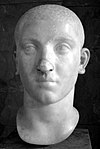
|
Severus Alexander CAESAR MARCVS AVRELIVS SEVERVS ALEXANDER AVGVSTVS |
October 1, 208 AD, Arca Caesarea, Syria | Grandson of Septimius Severus's sister-in-law, cousin and adoptive heir of Elagabalus | March 13, 222 AD – March 18, 235 AD | March 18, 235 AD Murdered by the army |
13 years |
Emperors during the Crisis of the Third Century
[edit]| Portrait | Name | Birth | Succession | Reign | Death | Time in Office |
|---|---|---|---|---|---|---|
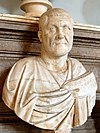
|
Maximinus I CAESAR GAIVS JVLIVS VERVS MAXIMINVS AVGVSTVS |
c.173 AD, Thrace or Moesia | Proclaimed emperor by German legions after the murder of Severus Alexander | March 20, 235 AD – June 238 AD | June 238 AD Assassinated by Praetorian Guard |
3 years, 3 month |

|
Gordian I CAESAR MARCVS ANTONIVS GORDIANVS SEMPRONIANVS AFRICANVS AVGVSTVS |
c. 159 AD, Phrygia? | Proclaimed emperor, whilst Pro-consul in Africa, during a revolt against Maximinus. Ruled jointly with his son Gordian II, and in opposition to Maximinus. Technically a usurper, but retrospectively legitimised by the accession of Gordian III | March 22, 238 AD – April 12, 238 AD | April 238 AD Committed suicide upon hearing of the death of Gordian II. |
21 days |
| Gordian II CAESAR MARCVS ANTONIVS GORDIANVS SEMPRONIANVS ROMANVS AFRICANVS AVGVSTVS |
c. 192 AD, ? | Proclaimed emperor, alongside father Gordian I, in opposition to Maximinus by act of the Senate. | March 22, 238 AD – April 12, 238 AD | April 238 AD Killed during the Battle of Carthage, fighting a pro-Maximinus army |
21 days | |
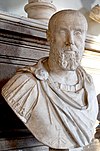
|
Pupienus CAESAR MARCVS CLODIVS PVPIENVS MAXIMVS AVGVSTVS |
c. 178 AD, ? | Proclaimed joint emperor with Balbinus by the Senate in opposition to Maximinus; later co-emperor with Balbinus. | April 22, 238 AD – July 29, 238 AD | July 29, 238 AD Assassinated by the Praetorian Guard |
3 Months |

|
Balbinus CAESAR DECIMVS CAELIVS CALVINVS BALBINVS PIVS AVGVSTVS |
? | Proclaimed joint emperor with Pupienus by the Senate after death of Gordian I & II, in opposition to Maximinus; later co-emperor with Pupienus and Gordian III | April 22, 238 AD – July 29, 238 AD | July 29, 238 AD Assassinated by Praetorian Guard |
3 Months |
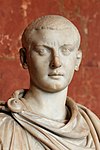
|
Gordian III CAESAR MARCVS ANTONIVS GORDIANVS AVGVSTVS |
January 20, 225 AD, Rome | Proclaimed emperor by supporters of Gordian I & II, then by the Senate; joint emperor with Pupienus and Balbinus until July 238 AD. | April 22, 238 AD – February 11, 244 AD | February 11, 244 AD Unknown; possibly murdered on orders of Philip I |
6 Years |

|
Philip I CAESAR MARCVS IVLIVS PHILLIPVS AVGVSTVS with Philip II |
c. 204 AD, Shahba, Syria | Praetorian Prefect to Gordian III, took power after his death; made his son Philip II co-emperor in summer 247 AD | February 244 AD – September/October 249 AD | September/October 249 AD Killed in battle against Trajan Decius, near Verona |
5 Years |
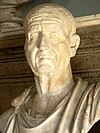
|
Trajan Decius CAESAR GAIVS MESSIVS QVINTVS TRAIANVS DECIVS AVGVSTVS with Herennius Etruscus |
c. 201 AD, Budalia, Lower Pannonia | Governor under Philip I; proclaimed emperor by Danubian legions and defeated Philip in battle; made his son Herennius Etruscus co-emperor in early 251 AD | September/ October 249 AD – June 251 AD | June 251 AD Both killed in the Battle of Abrittus fighting against the Goths |
2 Years |
| Hostilian CAESAR CAIVS VALENS HOSTILIANVS MESSIVS QVINTVS AVGVSTVS |
Rome | Son of Trajan Decius, accepted as heir by the Senate | June 251 AD – late 251 AD | September/October 251 AD Natural causes (Plague) |
4-5 Months | |

|
Trebonianus Gallus CAESAR GAIVS VIBIVS TREBONIANVS GALLVS AVGVSTVS with Volusianus |
206 AD, Italia | Governor of Moesia Superior, proclaimed emperor by Danubian legions after Trajan Decius's death (and in opposition to Hostilian); made his son Volusianus co-emperor in late 251 AD. | June 251 AD – August 253 AD | August 253 AD Assassinated by their own troops, in favour of Aemilian |
2 Years |
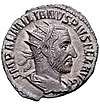
|
Aemilian CAESAR MARCVS AEMILIVS AEMILIANVS AVGVSTVS |
c. 207 AD Africa | Governor of Moesia Superior, proclaimed emperor by Danubian legions after defeating the Goths; accepted as emperor after death of Gallus | August 253 AD – October 253 AD | September/October 253 AD Assassinated by his own troops, in favour of Valerian |
2 Months |
| Valerian CAESAR PVBLIVS LICINIVS VALERIANVS AVGVSTVS |
c. 195 AD | Governor of Noricum and Raetia, proclaimed emperor by Rhine legions after death of Gallus; accepted as emperor after death of Aemilian | October 253 AD – 260 AD | After 260 AD Captured in Battle of Edessa against Persians, died in captivity |
7 Years | |

|
Gallienus CAESAR PVBLIVS LICINIVS EGNATIVS GALLIENVS AVGVSTVS with Saloninus |
218 AD | Son of Valerian, made co-emperor in 253 AD; his son Saloninus is very briefly co-emperor in c. July before assassination by Postumus. | October 253 AD – September 268 AD | September 268 AD Murdered at Aquileia by his own commanders. |
15 Years |

|
Claudius Gothicus CAESAR MARCVS AVRELIVS CLAVDIVS AVGVSTVS |
May 10, 213 AD/214 AD, Sirmium | Victorious general at Battle of Naissus, seized power after Gallienus's death | September 268 AD – January 270 AD | January 270 AD Natural causes (Plague) |
1 Year, 4 Months |

|
Quintillus CAESAR MARCVS AVRELIVS CLAVDIVS QVINTILLVS AVGVSTVS |
?, Sirmium | Brother of Claudius Gothicus, seized power after his death | January 270 AD – 270 AD | 270 AD Unclear; possibly suicide or murder |
Unknown |
| Aurelian CAESAR LVCIVS DOMITIVS AVRELIANVS AVGVSTVS |
September 9, 214 AD/215 AD, Sirmium | Proclaimed emperor by Danubian legions after Claudius II's death, in opposition to Quintillus | September(?) 270 AD – September 275 AD | September 275 AD Assassinated by Praetorian Guard |
5 Years | |

|
Tacitus CAESAR MARCVS CLAVDIVS TACITVS AVGVSTVS |
c. 200, Interamna | Elected by the Senate to replace Aurelian, after a short interregnum | September 25, 275 AD – June 276 AD | June 276 AD Natural causes (possibly assassinated) |
9 Months |
| Florian CAESAR MARCVS ANNIVS FLORIANVS AVGVSTVS |
? | Brother of Tacitus, elected by the army in the west to replace him | June 276 AD – September? 276 AD | September? 276 AD Assassinated by his own troops, in favour of Probus |
3 Months | |

|
Probus CAESAR MARCVS AVRELIVS PROBVS AVGVSTVS |
232 AD, Sirmium | Governor of the eastern provinces, proclaimed emperor by Danubian legions in opposition to Florian | September? 276 AD – September/ October 282 AD | September/ October 282 AD Assassinated by his own troops, in favour of Carus |
6 Years |

|
Carus CAESAR MARCVS AVRELIVS CARVS AVGVSTVS |
c. 230 AD, Narbo | Praetorian Prefect to Probus; seized power either before or after Probus was murdered | September/ October 282 AD – late July/ early August 283 AD | Late July/early August 283 AD Natural causes? (Possibly killed by lightning) |
10-11 Months |

|
Numerian CAESAR MARCVS AVRELIVS NVMERIVS NVMERIANVS AVGVSTVS |
? | Son of Carus, succeeded him jointly with his brother Carinus | Late July/early August 283 AD – 284 AD? | 284 AD Unclear; possibly assassinated |
1 Year |

|
Carinus CAESAR MARCVS AVRELIVS CARINVS AVGVSTVS |
? | Son of Carus, succeeded him jointly with his brother Numerian | Late July/early August 283 AD – 285 AD | 285 AD Died in battle against Diocletian? |
2 Years |
The Dominate
[edit]Tetrarchy and Constantinian dynasty
[edit]| Portrait | Name | Birth | Succession | Reign | Death | Time in Office |
|---|---|---|---|---|---|---|

|
Diocletian CAESAR GAIVS AVRELIVS VALERIVS DIOCLETIANVS AVGVSTVS |
c. December 22, 244 AD, Salona | Proclaimed emperor by army after death of Numerian, and in opposition to Carinus; adopted Maximian as senior co-emperor in 286 AD | November 20, 285 AD – May 1, 305 AD | 3 December 311 AD Abdicated; died of natural causes in Aspalatos |
20 years |
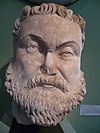
|
Maximian CAESAR GAIVS AVRELIVS VALERIVS MAXIMIANVS AVGVSTVS |
c. 250 AD, near Sirmium, Pannonia | Adopted as senior co-emperor ('Augustus') in the west by Diocletian in 286 AD | April 1, 286 AD – May 1, 305 AD | 310 AD Abdicated with Diocletian; twice tried to regain throne with, and then from Maxentius; captured by Constantine I and committed suicide at his behest |
19 years |
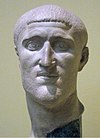
|
Constantius I Chlorus CAESAR GAIVS FLAVIVS VALERIVS CONSTANTIVS AVGVSTVS |
March 31 c. 250 AD, Dardania, Moesia | Adopted as junior co-emperor ('Caesar') and heir by Maximian in 293 AD | May 1, 305 AD – July 25, 306 AD | 306 AD Natural causes |
1 year and 2 months |
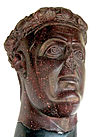
|
Galerius CAESAR GALERIVS VALERIVS MAXIMIANVS AVGVSTVS |
c. 260 AD, Felix Romuliana, Moesia Superior | Adopted as junior co-emperor ('Caesar') and heir by Diocletian in 293 AD | May 1, 305 AD – May 311 AD | 311 AD Natural causes |
6 years |

|
Severus II FLAVIVS VALERIVS SEVERVS AVGVSTVS |
? | Adopted as junior co-emperor ('Caesar') and heir by Constantius I Chlorus in 305 AD; succeeded as Augustus in 306; opposed by Maxentius and Constantine I | Summer 306 AD – March/ April 307 AD | September 16, 307 AD Captured by Maxentius and forced to commit suicide (or murdered) |
1 year |

|
Constantine I CAESAR FLAVIVS CONSTANTINVS VALERIVS AVGVSTVS |
February 27 c. 272 AD, Naissus, Moesia Superior | Son of Constantius I Chlorus, proclaimed emperor by his father's troops; accepted as Caesar (west) by Galerius in 306 AD; promoted to Augustus (west) in 307 AD by Maximian after death of Severus II; refused relegation to Caesar in 309 AD | 25 July 306 AD – May 22, 337 AD | May 22, 337 AD Natural causes |
31 years |
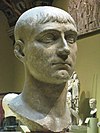
|
Maxentius MARCVS AVRELIVS VALERIVS MAXENTIVS AVGVSTVS |
c. 278 AD, ? | Son of Maximian, seized power in 306 after death of Constantius I Chlorus, in opposition to Severus and Constantine I; made Caesar (west) by Maximian in 307 AD after the death of Severus | 28 October 306 AD – October 28, 312 AD | October 28, 312 AD Died at the Battle of the Milvian Bridge, against Constantine I |
6 years |
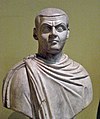
|
Maximinus II CAESAR GALERIVS VALERIVS MAXIMINVS AVGVSTVS |
November 20 c. 270 AD, Dacia Aureliana | Nephew of Galerius, adopted as Caesar and his heir in 305 AD; succeeded as Augustus (shared with Licinius I) in 311 AD | May 1, 311 AD – July/August 313 AD | July/August 313 AD Defeated in civil war against Licinius I; probably committed suicide thereafter |
2 years |

|
Licinius I CAESAR GAIVS VALERIVS LICINIVS AVGVSTVS with Valerius Valens Martinian |
c. 250 AD, Felix Romuliana, Moesia Superior | Appointed Augustus in the west by Galerius in 308 AD, in opposition to Maxentius; became Augustus in the east in 311 AD after the death of Galerius (shared with Maximinus II); defeated Maximinus in civil war to become sole eastern Augustus in 313 AD; appointed Valerius Valens in 317 AD, and Martinian in 324 AD as western Augustus, in opposition to Constantine, both being executed within weeks. | November 11, 308 AD – September 18, 324 AD | 325 AD Defeated in civil war against Constantine I in 324 AD and captured; executed on the orders of Constantine the next year |
16 years |

|
Constantine II CAESAR FLAVIVS CLAVDIVS CONSTANTINVS AVGVSTVS |
316 AD, Arles | Son of Constantine I; appointed Caesar in 317 AD, succeeded as joint Augustus with his brothers Constantius II and Constans I | May 22, 337 AD – 340 AD | 340 AD Died in battle against Constans I |
3 years |
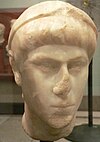
|
Constantius II CAESAR FLAVIVS IVLIVS CONSTANTIVS AVGVSTVS |
August 7, 317 AD, Sirmium, Pannonia | Son of Constantine I; succeeded as joint Augustus with his brothers Constantine II and Constans I; sole emperor from 350 AD | May 22, 337 AD – November 3, 361 AD | 361 AD Natural causes |
24 Years |
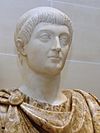
|
Constans I CAESAR FLAVIVS IVLIVS CONSTANS AVGVSTVS |
320 AD, ? | Son of Constantine I; succeeded as joint Augustus with his brothers Constantine II and Constantius II | May 22, 337 AD – 350 AD | 350 AD Assassinated on the orders of the usurper Magnentius |
13 Years |

|
Vetranio | ?, Moesia | General of Constans I, proclaimed Caesar against Magnentius and temporarily accepted as Augustus of the west by Constantius II. | March 1 – December 25, 350 AD | c. 356 As a private citizen, after abdication. |
9 Months |
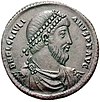
|
Julian II CAESAR FLAVIVS CLAVDIVS IVLIANVS AVGVSTVS |
331 AD/332 AD, Constantinople, Thracia | Cousin of Constantius II; made Caesar of the west in 355 AD; proclaimed Augustus by his troops in 360; sole emperor after the death of Constantius | February 360 AD – June 26, 363 AD | June 26, 363 AD Mortally wounded in battle |
3 Years |

|
Jovian CAESAR FLAVIVS IOVIANVS AVGVSTVS |
331 AD, Singidunum, Moesia | General of Julian's army; proclaimed emperor by the troops on Julian's death | June 26, 363 AD – February 17, 364 AD | February 17, 364 AD Natural causes (suffocated on fumes) |
1 Year |
Valentinian dynasty
[edit]| Portrait | Name | Birth | Succession | Reign | Death | Time in Office |
|---|---|---|---|---|---|---|
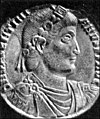
|
Valentinian I FLAVIVS VALENTINIANVS AVGVSTVS |
321 AD, Cibalae, Pannonia | Elected to replace Jovian by the army | February 26, 364 AD – November 17, 375 AD | November 17, 375 AD Natural causes |
11 Years |
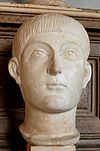
|
Valens FLAVIVS IVLIVS VALENS AVGVSTVS |
328 AD, Cibalae, Pannonia | Brother of Valentinian I, appointed co-augustus (for the east) by him | March 28, 364 AD – August 9, 378 AD | August 9, 378 AD Killed in Battle of Adrianople against the Goths |
14 Years |

|
Gratian FLAVIVS GRATIANVS AVGVSTVS |
April 18/May 23, 359 AD, Sirmium, Pannonia | Son of Valentinian I, appointed 'junior' Augustus by him in 367, became 'senior' augustus (for the west) after Valentinian's death. | August 4, 367 AD – August 25, 383 AD | August 25, 383 AD Murdered by rebellious army faction |
16 Years |
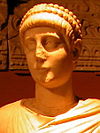
|
Valentinian II FLAVIVS VALENTINIANVS INVICTVS AVGVSTVS |
371 AD, Milan, Italia | Son of Valentinian I, proclaimed emperor by Pannonian army after Valentinian's death; accepted as co-Augustus for the west by Gratian | November 17, 375 AD – May 15, 392 AD | May 15, 392 AD Unclear; possibly murdered or committed suicide |
17 Years |
Theodosian dynasty
[edit]| Portrait | Name | Birth | Succession | Reign | Death | Time in Office |
|---|---|---|---|---|---|---|
| Theodosius I FLAVIVS THEODOSIVS AVGVSTVS |
January 11, 347 AD, Cauca, Hispania | Appointed as Augustus for the east by Gratian after the death of Valens; became sole 'senior' Augustus after death of Valentinian II | January 1, 379 AD – January 17, 395 AD | January 17, 395 AD Natural causes |
16 Years | |
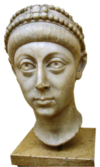
|
Arcadius FLAVIVS ARCADIVS AVGVSTVS EAST |
c. 377 AD, Hispania | Son of Theodosius I; appointed as 'junior' Augustus for the east by Theodosius in 383 (after the death of Gratian); became 'senior' Augustus for the east after his father's death | January 383 AD – May 1, 408 AD | May 1, 408 AD Natural causes |
25 Years |

|
Honorius FLAVIVS HONORIVS AVGVSTVS WEST |
September 9, 384 AD, ? | Son of Theodosius I; appointed as 'junior' Augustus for the west by Theodosius in 393 (after the death of Valentinian II); became 'senior' Augustus for the west after his father's death | January 23, 393 AD – August 15, 423 AD | August 15, 423 AD Natural causes |
30 Years |

|
Theodosius II FLAVIVS THEODOSIVS AVGVSTVS EAST |
April 10, 401 AD, Constantinople? | Son of Arcadius; appointed as 'junior' Augustus for the east by Arcadius in 402; became 'senior' Augustus for the east after his father's death | January 402 AD – July 28, 450 AD | July 28, 450 AD Natural causes |
48 Years |
| Constantius III FLAVIVS CONSTANTIVS AVGVSTVS WEST |
?, Naissus, Moesia Superior | Married to Theodosius I's daughter Galla Placidia, elevated to co-Augustus for the west by Honorius | February 8, 421 AD – September 2, 421 AD | September 2, 421 AD Natural causes |
7 Months | |
| Joannes WEST |
? | A senior civil servant under Honorius, proclaimed emperor by Castinus; not recognized by the Eastern Empire | August 27, 423 AD – May 425 AD | June or July 425 AD Defeated in battle by Theodosius II and Valentinian III, captured and executed |
2 Years | |

|
Valentinian III FLAVIVS PLACIDIVS VALENTINIANVS AVGVSTVS WEST |
July 2, 419 AD, Ravenna, Italia | Son of Constantius III, appointed Caesar for the west by Theodosius II after the death of Honorius, in opposition to the Johannes; became Augustus for the west after the defeat of Johannes | October 23, 424 AD – March 16, 455 AD | March 16, 455 AD Assassinated, possibly at the behest of Petronius Maximus |
31 Years |
| Marcian FLAVIVS MARCIANIVS AVGVSTVS EAST |
396, Thrace or Illyria | Nominated as successor (and husband) by Pulcheria, sister of Theodosius II | Summer 450 AD – January 457 AD | January 457 AD Natural causes |
7 Years |
The last emperors of the Western Empire
[edit]| Portrait | Name | Birth | Succession | Reign | Death | Time in Office |
|---|---|---|---|---|---|---|
| Petronius Maximus FLAVIVS ANICIVS PETRONIVS MAXIMVS AVGVSTVS |
c. 396 AD, ? | Proclaimed himself emperor with the support of the army, after the death of Valentinian III. Not recognized by the Eastern Empire. | March 17, 455 AD – May 31, 455 AD | May 31, 455 AD Murdered, probably stoned to death by the Roman mob |
2 Months | |
| Avitus EPARCHIVS AVITVS AVGVSTVS |
c. 385 AD, ? | Magister militum under Petronius Maximus, proclaimed emperor by the Visigoth king Theoderic II after Petronius's death | July 9, 455 AD – October 17, 456 AD | after 17 October 456 AD Deposed by his Magister militum, Ricimer; became bishop of Placentia; murdered at some point afterwards |
1 Year | |

|
Majorian IVLIVS VALERIVS MAIORIANVS AVGVSTVS |
November 420 AD, ? | Appointed emperor by Ricimer | April 457 AD – August 2, 461 AD | August 7, 461 AD Deposed by his troops (probably at the behest of Ricimer); beheaded on the orders of Ricimer |
4 Years |

|
Libius Severus LIBIVS SEVERVS AVGVSTVS |
?, Lucania, Italia | Appointed emperor by Ricimer. Not recognized by the Eastern Empire. | November 461 AD – August 465 AD | August 465 AD Probably poisoned by Ricimer |
4 Years |

|
Anthemius PROCOPIVS ANTHEMIVS AVGVSTVS |
c. 420 AD | Appointed emperor by Ricimer, with the backing of the eastern emperor Leo I | April 12, 467 AD – July 11, 472 AD | July 11, 472 AD Executed by Ricimer |
5 Years |

|
Olybrius FLAVIVS ANICIVS OLYBRIVS AVGVSTVS |
c. 420 AD | Son-in-law of Valentinian III; appointed emperor by Ricimer. Not recognized by the Eastern Empire. | July 11, 472 AD – November 2, 472 AD | November 2, 472 AD Natural causes |
4 Months |

|
Glycerius FLAVIVS(?) GLYCERIVS AVGVSTVS |
? | Appointed emperor by Gundobad (Ricimer's successor). Not recognized by the Eastern Empire. | March 473 AD – June 474 AD | after 480 AD Deposed by Julius Nepos, became Bishop of Salona, time and manner of death unknown |
1 Year |

|
Julius Nepos FLAVIVS IVLIVS NEPOS AVGVSTVS |
c. 430 AD - 480 AD | Nephew-in-law of the eastern emperor Leo I, appointed emperor in opposition to Glycerius | June 474 AD – August 28, 475 AD (in Italy); – Spring 480 AD (in Gaul and Dalmatia) | 480 AD Deposed in Italy by Flavius Orestes, ruled in balance of Western Empire until assassination in 480. Maintained as figurehead in Italy by Odoacer to his death in 480. |
1 Year/6 Years |

|
Romulus Augustus FLAVIVS ROMVLVS AVGVSTVS |
? | Appointed by his father, Flavius Orestes. Not recognized by the Eastern Empire. | October 31, 475 AD – September 4, 476 AD (in Italy) | Unknown. Regarded as emperor more from historical convention than accuracy, his rule never extended beyond portions of Italian peninsular and was not recognized by Eastern Emperor Zeno. Deposed by Odoacer, who then ruled in the name of Julius Nepos until the latter's death in 480, which formally ended the separate western empire; most likely lived out his life on a private villa in obscurity. |
1 Year |
Eastern emperors
[edit]Leonid dynasty (457–518)
[edit]| Name | Reign | Comments | |
|---|---|---|---|
 |
Leo I "the Thracian", "the Butcher", or "the Great" (Λέων Α' ο Θράξ, ο Μακέλλης, ο Μέγας, Flavius Valerius Leo) |
7 February 457 – 18 January 474 |
Born in Dacia ca. 400, and of Bessian origin, Leo became a low-ranking officer and served as an attendant of the Gothic commander-in-chief of the army, Aspar, who chose him as emperor on Marcian's death. He was the first emperor to be crowned by the Patriarch of Constantinople. His reign was marked by the pacification of the Danube frontier and peace with Persia, which allowed him to intervene in the affairs of the western empire, supporting candidates for the throne and dispatching an expedition to recover Carthage from the Vandals in 468. Initially a puppet of Aspar, Leo began promoting the Isaurians as a counterweight to Aspar's Goths, marrying his daughter Ariadne to the Isaurian leader Tarasicodissa (Zeno). With their support, in 471 Aspar was murdered and Gothic power over the army was broken.[2] |
 |
Leo II "the Little" (Λέων Β' ο Μικρός, Flavius Leo) |
18 January – 17 November 474 |
Born ca. 467, he was the grandson of Leo I by Leo's daughter Ariadne and her Isaurian husband, Zeno. Raised to Caesar and then co-emperor in autumn 473, soon after his accession Leo II crowned his father Zeno as co-emperor and effective regent. Died shortly after, possibly poisoned.[3] |
 |
Zeno (Ζήνων, Flavius Zeno) |
17 November 474 – 9 April 491 |
Born ca. 425 in Isauria, originally named Tarasicodissa. As the leader of Leo I's Isaurian soldiers, he rose to comes domesticorum, married the emperor's daughter Ariadne and took the name Zeno, and played a crucial role in the elimination of Aspar and his Goths. He was named co-emperor by his son on 9 February 474, and became sole ruler upon the latter's death, but had to flee to his native country before Basiliscus in 475, regaining control of the capital in 476. Zeno concluded peace with the Vandals, saw off challenges against him by Illus and Verina, and secured peace in the Balkans by enticing the Ostrogoths under Theodoric the Great to migrate to Italy. Zeno's reign also saw the end of the western line of emperors. His pro-Monophysite stance made him unpopular and his promulgation of the Henotikon resulted in the Acacian Schism with the papacy.[4] |
 |
Basiliscus (Βασιλίσκος, Flavius Basiliscus) |
9 January 475 – August 476 |
General and brother-in-law of Leo I, he seized power from Zeno but was again deposed by him. Died in 476/477 |
 |
Anastasius I (Αναστάσιος Α' ο Δίκορος, Flavius Anastasius) |
11 April 491 – 9 July 518 |
Born ca. 430 at Dyrrhachium, he was a palace official (silentiarius) when he was chosen as her husband and Emperor by Empress-dowager Ariadne. He was nicknamed "Dikoros", because of his heterochromia. Anastasius reformed the tax system and the Byzantine coinage and proved a frugal ruler, so that by the end of his reign he left a substantial surplus. His Monophysite sympathies led to wideaspread opposition, most notably the Revolt of Vitalian and the Acacian Schism. His reign was also marked by the first Bulgar raids into the Balkans and by a war with Persia over the foundation of Dara. He died childless.[5] |
Justinian dynasty (518–602)
[edit]| Name | Reign | Comments | |
|---|---|---|---|
 |
Justin I (Ιουστίνος Α', Flavius Iustinus) |
July 518 – 1 August 527 |
Born c. 450 at Bederiana (Justiniana Prima), Dardania. Officer and commander of the Excubitors bodyguard under Anastasius I, he was elected by army and people upon the death of Anastasius I. |
 |
Justinian I "the Great" (Ιουστινιανός Α' ο Μέγας, Flavius Petrus Sabbatius Iustinianus) |
1 August 527 – 13/14 November 565 |
Born in 482/483 at Tauresium (Taor), Macedonia. Nephew of Justin I, possibly raised to co-emperor on 1 April 527. Succeeded on Justin I's death. |
 |
Justin II (Ιουστίνος Β', Flavius Iustinus Iunior) |
14 November 565 – 5 October 578 |
Born c. 520. Nephew of Justinian I, he seized the throne on the death of Justinian I with support of army and Senate. Became insane, hence in 573–574 under the regency of his wife Sophia, and in 574–578 under the regency of Tiberius Constantine. |
 |
Tiberius II Constantine (Τιβέριος Β', Flavius Tiberius Constantinus) |
5 October 578 – 14 August 582 |
Born c. 535, commander of the Excubitors, friend and adoptive son of Justin. Was named Caesar and regent in 574. Succeeded on Justin II's death. |
 |
Maurice (Μαυρίκιος, Flavius Mauricius Tiberius) |
14 August 582 – 22 November 602 |
Born in 539 at Arabissus, Cappadocia. Became an official and later a general. Married the daughter of Tiberius II and succeeded him upon his death. Named his son Theodosius as co-emperor in 590. Deposed by Phocas and executed on 27 November 602 at Chalcedon. |
Non-dynastic (602–610)
[edit]| Name | Reign | Comments | |
|---|---|---|---|
 |
Phocas (Φωκάς, Flavius Phocas) |
23 November 602 – 4 October 610 |
Subaltern in the Balkan army, he led a rebellion that deposed Maurice. Increasingly unpopular and tyrannical, he was deposed and executed by Heraclius. |
Heraclian dynasty (610–695)
[edit]| Name | Reign | Comments | |
|---|---|---|---|
 |
Heraclius (Ηράκλειος, Flavius Heraclius) |
5 October 610 – 11 February 641 |
Born c. 575 as the eldest son of the Exarch of Africa, Heraclius the Elder. Began a revolt against Phocas in 609 and deposed him in October 610. Brought the Byzantine-Sassanid War of 602–628 to successful conclusion but was unable to stop the Muslim conquest of Syria. |
 |
Constantine III formally Heraclius New Constantine (Ηράκλειος νέος Κωνσταντίνος, Heraclius Novus Constantinus) |
11 February – 24/26 May 641 |
Born on 3 May 612 as the eldest son of Heraclius by his first wife Fabia Eudokia. Named co-emperor in 613, he succeeded to throne with his younger brother Heraklonas following the death of Heraclius. Died of tuberculosis, allegedly poisoned by Empress-dowager Martina. |
 |
Heraklonas (Ηρακλωνάς, Heraclianus) formally Constantine Heraclius (Κωνσταντίνος Ηράκλειος, Constantinus Heraclius) |
11 February 641 – September 641 |
Born in 626 to Heraclius' second wife Martina, named co-emperor in 638. Succeeded to throne with Constantine III following the death of Heraclius. Sole emperor after the death of Constantine III, under the regency of Martina, but was forced to name Constans II co-emperor by the army, and was deposed by the Senate in September 641. |
 |
Constans II (Κώνστας Β', Constantus II) formally Constantine "the Bearded", (Κωνσταντίνος ο Πωγωνάτος) |
September 641 – 15 September 668 |
Born on 7 November 630, the son of Constantine III. Raised to co-emperor in summer 641 after his father's death due to army pressure, he became sole emperor after the forced abdication of his uncle Heraklonas. Baptized Heraclius, he reigned as Constantine. "Constans" is his nickname. Moved his seat to Syracuse, where he was assassinated, possibly on the orders of Mezezius. |
 |
Constantine IV "the Bearded" (Κωνσταντίνος Δ' ο Πωγωνάτος) |
15 September 668 – September 685 |
Born in 652, he succeeded following the murder of his father Constans II. Erroneously called "Constantine the Bearded" by historians through confusion with his father. He repelled the First Arab Siege of Constantinople, and died of dysentery. |
 |
Justinian II "the Slit-nosed" (Ιουστινιανός Β' ο Ρινότμητος) |
September 685 – 695 |
Born in 669, he was named co-emperor in 681 and became sole emperor upon Constantine IV's death. Deposed by military revolt in 695, mutilated (hence his surname) and exiled to Cherson, whence he recovered his throne in 705. |
Twenty Years' Anarchy (695–717)
[edit]| Name | Reign | Comments | |
|---|---|---|---|
 |
Leontios (Λεόντιος) |
695–698 | General from Isauria, he deposed Justinian II and was overthrown in another revolt in 698. He was executed in February 706. |
 |
Tiberius III Apsimar (Τιβέριος Γ' Αψίμαρος) |
698–705 | Admiral of Germanic origin, originally named Apsimar. He rebelled against Leontios after a failed expedition. Reigned under the name of Tiberius until deposed by Justinian II in 705. Executed in February 706. |
 |
Justinian II "the Slit-nosed" (Ιουστινιανός Β' ο Ρινότμητος) |
August 705 – December 711 |
Returned on the throne with Bulgar support. Named son Tiberius as co-emperor in 706. Deposed and killed by military revolt. |
 |
Philippikos Bardanes (Φιλιππικός Βαρδάνης) |
December 711 – 3 June 713 |
A general of Armenian origin, he deposed Justinian II and was in turn overthrown by a revolt of the Opsician troops. |
 |
Anastasios II (Αναστάσιος Β') |
June 713 – November 715 |
Originally named Artemios. A bureaucrat and secretary under Philippikos, he was raised to the purple by the soldiers who overthrew Philippikos. Deposed by another military revolt, he led an abortive attempt to regain the throne in 718 and was killed. |
 |
Theodosios III (Θεοδόσιος Γ') |
May 715 – 25 March 717 |
A fiscal official, he was proclaimed emperor by the rebellious Opsician troops. Entered Constantinople in November 715. Abdicated following the revolt of Leo the Isaurian and became a monk. |
Isaurian dynasty (717–802)
[edit]| Name | Reign | Comments | |
|---|---|---|---|
 |
Leo III "the Isaurian" (Λέων Γ΄ ο Ίσαυρος) |
25 March 717 – 18 June 741 |
Born c. 685 in Germanikeia, Commagene, he became a general. Rose in rebellion and secured the throne in spring 717. Repelled the Second Arab Siege of Constantinople and initiated the Byzantine Iconoclasm. |
 |
Constantine V "the Dung-named" (Κωνσταντίνος Ε΄ ο Κοπρώνυμος) |
18 June 741 – 14 September 775 |
Born in July 718, the only son of Leo III. Co-emperor since 720, he succeeded upon his father's death. After overcoming the usurpation of Artabasdos, he continued his father's iconoclastic policies and won several victories against the Arabs and the Bulgars. He is given the surname "the Dung-named" in hostile later chroniclers. |
| Artabasdos (Αρτάβασδος) |
June 741/742 – 2 November 743 |
General and son-in-law of Leo III, Count of the Opsician Theme. Led a revolt that secured Constantinople, but was defeated and deposed by Constantine V, who blinded and tonsured him. | |
 |
Leo IV "the Khazar" (Λέων Δ΄ ο Χάζαρος) |
14 September 775 – 8 September 780 |
Born on 25 January 750 as the eldest son of Constantine V. Co-emperor since 751, he succeeded upon his father's death. |
 |
Constantine VI (Κωνσταντίνος ΣΤ΄) |
8 September 780 – August 797 |
Born in 771, the only child of Leo IV. Co-emperor in 776, sole emperor upon Leo's death in 780, until 790 under the regency of his mother, Irene of Athens. He was overthrown on Irene's orders, blinded and imprisoned, probably dying of his wounds shortly after. He was succeeded in 800 by Charlemagne. |
Carolingian dynasty
[edit]| Image | Name | Life | Coronation | Ceased to be Emperor | Descent from Emperor | Coin |
|---|---|---|---|---|---|---|
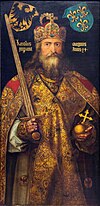 |
Charles I (Charlemagne) |
2 April 742 - 28 January 814 |
25 December 800 | 28 January 814 | Founder of the Holy Roman Empire |  |
 |
Louis I | 778 - 20 June 840 |
5 October 816 | 20 June 840 | son of Emperor Charles I |  |
 |
Lothair I | 795 - 29 September 855 |
5 April 823 | 29 September 855 | son of Emperor Louis I |  |
 |
Louis II | 825 - 12 August 875 |
1st Easter 850 2nd 18 May 872 |
12 August 875 | son of Emperor Lothair I |  |
 |
Charles II | 13 June 823 - 6 October 877 |
29 December 875 | 6 October 877 | son of Emperor Louis I |  |
 |
Charles III | 13 June 839 - 13 January 888 |
12 February 881 | 13 January 888 | grandson of Emperor Louis I |  |
Guideschi dynasty
[edit]| Image | Name | Life | Coronation | Ceased to be Emperor | Descent from Emperor | Coin |
|---|---|---|---|---|---|---|
 |
Guy | 855 - 12 December 894 |
May 891 | 12 December 894 | great-great grandson of Emperor Charles I | - |
 |
Lambert | 880 - 15 October 898 |
30 April 892 | 15 October 898 | son of Emperor Guy | - |
Carolingian dynasty
[edit]| Image | Name | Life | Coronation | Ceased to be Emperor | Descent from Emperor | Coin |
|---|---|---|---|---|---|---|
 |
Arnulph | 850 - 8 December 899 |
22 February 896 | 8 December 899 | nephew of Charles III and great-grandson of Emperor Louis I |
- |
Bosonid dynasty
[edit]| Image | Name | Life | Coronation | Ceased to be Emperor | Descent from Emperor | Coin |
|---|---|---|---|---|---|---|
 |
Louis III | 880 - 28 June 928 |
22 February 901 | 21 July 905 | grandson of Emperor Louis II | - |
Unruoching dynasty
[edit]| Image | Name | Life | Coronation | Ceased to be Emperor | Descent from Emperor | Coin |
|---|---|---|---|---|---|---|
 |
Berengar | 845 - 7 April 924 |
December 915 | 7 April 924 | grandson of Emperor Louis I | - |
There was no emperor in the west between 924 and 962.
Holy Roman Emperors
[edit]Ottonian (Saxon) dynasty
[edit]| # | Image | Name | Life | Election | Coronation | Ceased to be Emperor | Descent from Emperor | Seal |
|---|---|---|---|---|---|---|---|---|
| 1 | 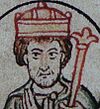 |
Otto I | 23 November 912 - 7 May 973 |
- | 2 February 962 | 7 May 973 | perhaps great-great-great grandson of Emperor Louis I[citation needed] |  |
| 2 |  |
Otto II | 955 - 7 December 983 |
961 | 25 December 967 | 7 December 983 | son of Emperor Otto I | |
| 3 |  |
Otto III | 980 - 23 January 1002 |
June 983 | 21 May 996 | 23 January 1002 | son of Emperor Otto II |  |
| 4 |  |
Henry II [6] |
6 May 973 - 13 July 1024 |
7 June 1002 | 14 February 1014 | 13 July 1024 | second cousin of Emperor Otto III and great-great-great-great-great grandson of Emperor Louis I |
Salian (Frankish) dynasty
[edit]| # | Image | Name | Life | Election | Coronation | Ceased to be Emperor | Descent from Emperor | Seal |
|---|---|---|---|---|---|---|---|---|
| 5 |  |
Conrad II [7] |
990 - 4 June 1039 |
1024 | 26 March 1027 | 4 June 1039 | great-great-grandson of Emperor Otto I | |
| 6 |  |
Henry III | 29 October 1017 - 5 October 1056 |
1028 | 25 December 1046 | 5 October 1056 | son of Emperor Conrad II |  |
| 7 |  |
Henry IV | 11 November 1050 - 7 August 1106 |
1053 | 31 March 1084 | December 1105 | son of Emperor Henry III |  |
| 8 |  |
Henry V [8] |
8 November 1086 - 23 May 1125 |
6 January 1099 | 13 April 1111 | 23 May 1125 | son of Emperor Henry IV |  |
Supplinburg dynasty
[edit]| # | Image | Name | Life | Election | Coronation | Ceased to be Emperor | Descent from Emperor | Seal |
|---|---|---|---|---|---|---|---|---|
| 9 |  |
Lothair III [9] |
9 June 1075 - 4 December 1137 |
1125 | 4 June 1133 | 4 December 1137 | perhaps 9th generation descendant of Emperor Otto I or 11th generation descendant of Emperor Charles II |
 |
Staufen (or Hohenstaufen) dynasty
[edit]| # | Image | Name | Life | Election | Coronation | Ceased to be Emperor | Descent from Emperor | Arms |
|---|---|---|---|---|---|---|---|---|
| 10 |  |
Frederick I | 1122 - 10 June 1190 |
4 March 1152 | 18 June 1155 | 10 June 1190 | great-grandson of Emperor Henry IV |  |
| 11 |  |
Henry VI | November 1165 - 28 September 1197 |
?April 1169 | 14 April 1191 | 28 September 1197 | son of Emperor Frederick I |  |
Welf dynasty
[edit]| # | Image | Name | Life | Election | Coronation | Ceased to be Emperor | Descent from Emperor | Arms |
|---|---|---|---|---|---|---|---|---|
| 12 |  |
Otto IV | 1175 or 1176 - 19 May 1218 |
9 June 1198 | 4 October 1209 | 1215 | great-grandson of Emperor Lothair III |  |
Staufen (or Hohenstaufen) dynasty
[edit]| # | Image | Name | Life | Election | Coronation | Ceased to be Emperor | Descent from Emperor | Arms |
|---|---|---|---|---|---|---|---|---|
| 13 | 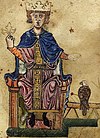 |
Frederick II | 26 December 1194 - 13 December 1250 |
1196 1215 re-election |
22 November 1220 | 13 December 1250 | son of Emperor Henry VI |  |
House of Luxembourg
[edit]| # | Image | Name | Life | Election | Coronation | Ceased to be Emperor | Descent from Emperor | Arms |
|---|---|---|---|---|---|---|---|---|
| 14 | 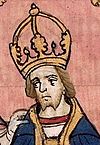 |
Henry VII | 1275/1279 - 24 August 1313 |
1308 | 29 June 1312 | 24 August 1313 | 13th generation descendant of Emperor Louis III |  |
House of Wittelsbach
[edit]| # | Image | Name | Life | Election | Coronation | Ceased to be Emperor | Descent from Emperor | Arms |
|---|---|---|---|---|---|---|---|---|
| 15 |  |
Louis IV | 1 April 1282 - 11 October 1347 |
October 1314 | 17 January 1328 | 11 October 1347 | 6th generation descendant of Emperor Lothair III and 7th generation descendant of Henry IV, Holy Roman Emperor |  |
House of Luxembourg
[edit]| # | Image | Name | Life | Election | Coronation | Ceased to be Emperor | Descent from Emperor | Arms |
|---|---|---|---|---|---|---|---|---|
| 16 | 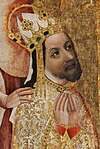 |
Charles IV | 14 May 1316 - 29 November 1378 |
11 July 1346/ 17 June 1349 re-election |
5 April 1355 | 29 November 1378 | grandson of Emperor Henry VII |  |
| 17 |  |
Sigismund | 14 February 1368 - 9 December 1437 |
10 September 1410/ 21 July 1411 re-election |
31 May 1433 | 9 December 1437 | son of Emperor Charles IV |  |
House of Habsburg
[edit]| # | Image | Name | Life | Election | Coronation | Ceased to be Emperor | Descent from an Emperor | Arms |
|---|---|---|---|---|---|---|---|---|
| 18 | 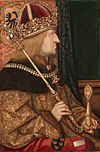 |
Frederick III | 21 September 1415 - 19 August 1493 |
1440 | 19 March 1452 | 19 August 1493 | 10th generation descendant of Emperor Lothair III |  |
| 19 | 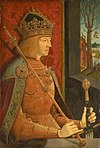 |
Maximilian I | 22 March 1459 - 12 January 1519 |
16 February 1486 | - [10] |
12 January 1519 | son of Emperor Frederick III |  |
| 20 |  |
Charles V | 24 February 1500 - 21 September 1558 |
28 June 1519 | February 1530 | 16 January 1556 | grandson of Emperor Maximilian I |  |
| 21 |  |
Ferdinand I | 10 March 1503 - 25 July 1564 |
1531 | - [10] |
25 July 1564 | grandson of Emperor Maximilian I |  |
| 22 | 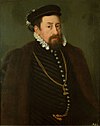 |
Maximilian II | 31 July 1527 - 12 October 1576 |
November 1562 | - [10] |
12 October 1576 | son of Emperor Ferdinand I |  |
| 23 |  |
Rudolph II [11] |
18 July 1552 - 20 January 1612 |
1575 | 30 June 1575 | 20 January 1612 | son of Emperor Maximilian II |  |
| 24 |  |
Matthias | 24 February 1557 - 20 March 1619 |
1612 | 23 January 1612 | 20 March 1619 | son of Emperor Maximilian II |  |
| 25 |  |
Ferdinand II | 9 July 1578 - 15 February 1637 |
1618 | 10 March 1619 | 15 February 1637 | great-grandson of Emperor Ferdinand I |  |
| 26 |  |
Ferdinand III | 13 July 1608 - 2 April 1657 |
1636 | 18 November 1637 | 2 April 1657 | son of Emperor Ferdinand II |  |
| 27 |  |
Leopold I | 9 June 1640 - 5 May 1705 |
July 1658 | 6 March 1657 | 5 May 1705 | son of Emperor Ferdinand III |  |
| 28 |  |
Joseph I | 26 July 1678 - 17 April 1711 |
6 January 1690 | 1 May 1705 | 17 April 1711 | son of Emperor Leopold I |  |
| 29 |  |
Charles VI | 1 October 1685 - 20 October 1740 |
12 October 1711 | 22 December 1711 | 20 October 1740 | son of Emperor Leopold I |  |
House of Wittelsbach
[edit]| # | Image | Name | Life | Election | Coronation | Ceased to be Emperor | Descent from Emperor | Arms |
|---|---|---|---|---|---|---|---|---|
| 30 |  |
Charles VII [10] |
6 August 1697 - 20 January 1745 |
24 January 1742 | 12 February 1742 | 20 January 1745 | great-great grandson of Emperor Ferdinand II and 12th generation descendant of Louis IV, Holy Roman Emperor |  |
House of Habsburg-Lorraine
[edit]| # | Image | Name | Life | Election | Coronation | Ceased to be Emperor | Descent from an Emperor | Arms |
|---|---|---|---|---|---|---|---|---|
| 31 |  |
Francis I | 8 December 1708 - 18 August 1765 |
13 September 1745 | - [10] |
18 August 1765 | great grandson of Emperor Ferdinand III |  |
| 32 |  |
Joseph II | 13 March 1741 - 20 February 1790 |
after 18 August 1765 | 19 August 1765 | 20 February 1790 | son of Emperor Francis I and maternal grandson of Emperor Charles VI |  |
| 33 |  |
Leopold II | 5 May 1747 - 1 March 1792 |
after 20 February 1790 | - [10] |
1 March 1792 | son of Emperor Francis I and maternal grandson of Emperor Charles VI |  |
| 34 | 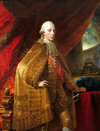 |
Francis II | 12 February 1768 - 2 March 1835 |
after 1 March 1792 | 4 March 1792 | 6 August 1806 | son of Emperor Leopold II |  |
- ^ The other claimants for the throne in the Year of the Five Emperors were Pescennius Niger and Clodius Albinus, supported by the Syrian and British legions respectively. Although not completely defeated until 197 AD, they were not formally accepted by the senate and were therefore not technically reigning emperors.
- ^ Gregory, Timothy E.; Cutler, Anthony (1991). "Leo I". In Kazhdan, Alexander P. (ed.). Oxford Dictionary of Byzantium. New York; Oxford: Oxford University Press. pp. 1206–1207. ISBN 978-0-19-504652-6.
- ^ Kazhdan, Alexander P. (1991). "Leo II". In Kazhdan, Alexander P. (ed.). Oxford Dictionary of Byzantium. New York; Oxford: Oxford University Press. pp. 1207–1208. ISBN 978-0-19-504652-6.
- ^ Gregory, Timothy E. (1991). "Zeno". In Kazhdan, Alexander P. (ed.). Oxford Dictionary of Byzantium. New York; Oxford: Oxford University Press. p. 2223. ISBN 978-0-19-504652-6.
- ^ Gregory, Timothy E. (1991). "Anastasios I". In Kazhdan, Alexander P. (ed.). Oxford Dictionary of Byzantium. New York; Oxford: Oxford University Press. pp. 86–87. ISBN 978-0-19-504652-6.
- ^ enumerated as successor of Henry I who was German King 919–936 but not Emperor.
- ^ enumerated as successor of Conrad I who was German King 911–918 but not Emperor
- ^ Barraclough, Geoffrey (1984). The Origins of Modern Germany. W. W. Norton & Company. ISBN 0-393-30153-2.
- ^ enumerated as successor of Lothair II, who was King of Lotharingia 855–869 but not Emperor
- ^ a b c d e f Emperor-Elect.
- ^ enumerated as successor of Rudolph I who was German King 1273–1291.
